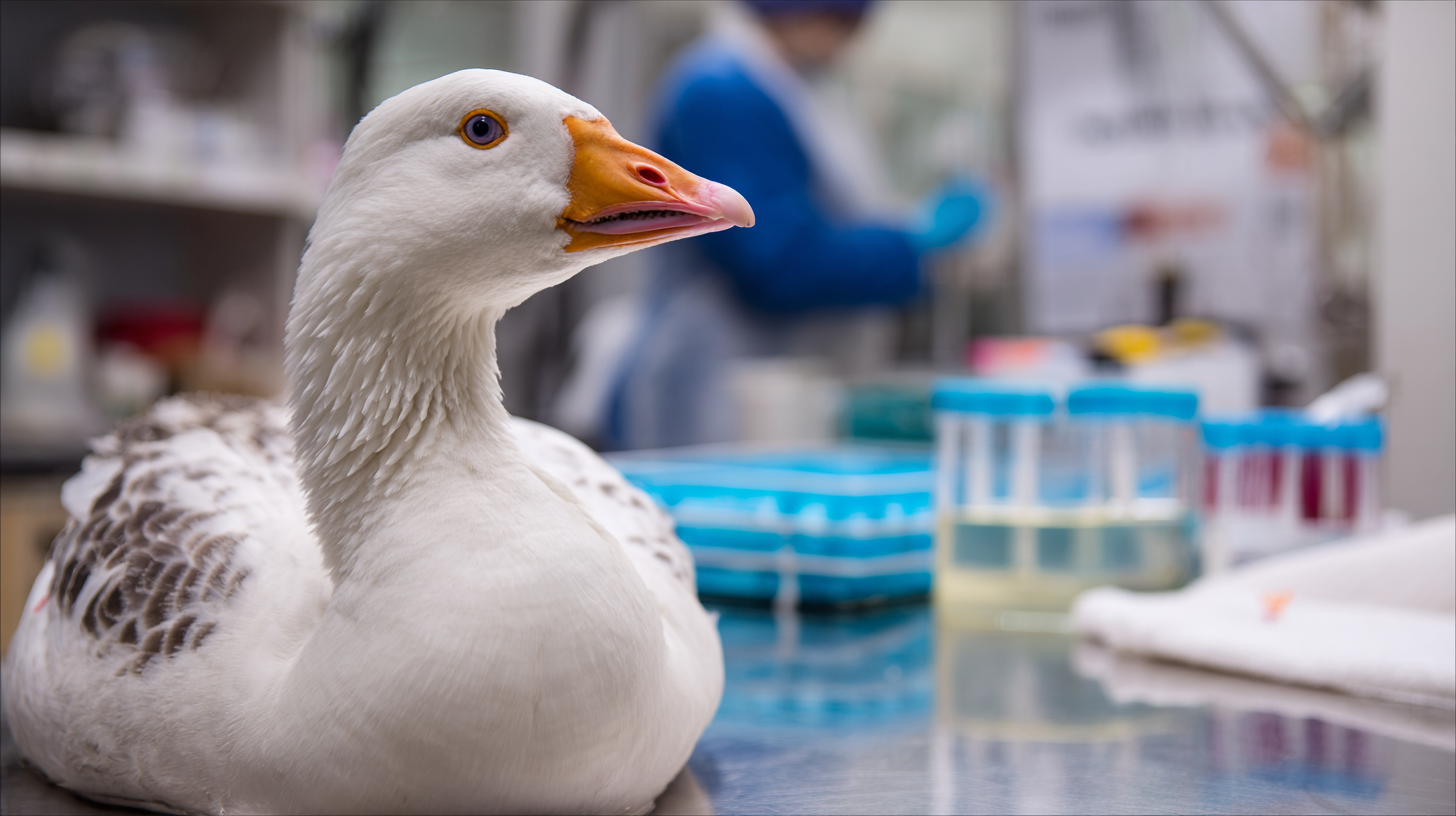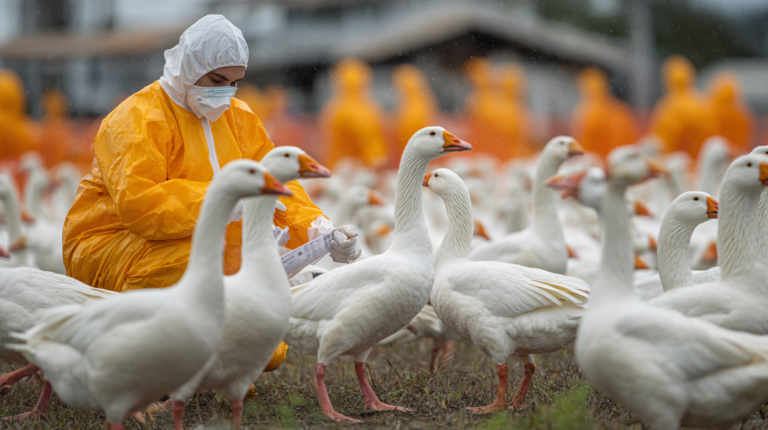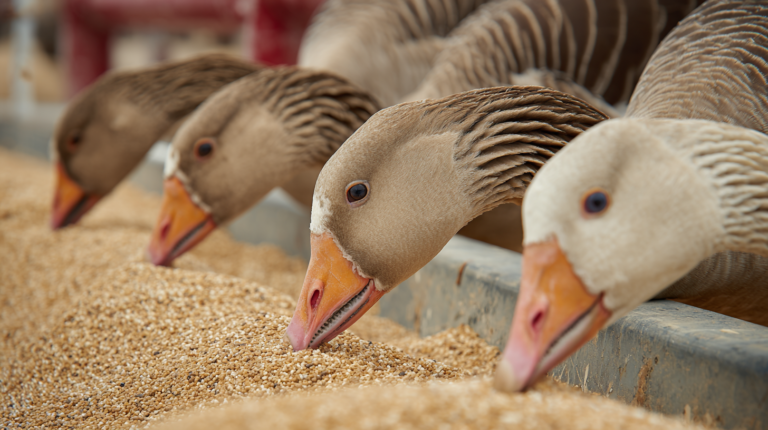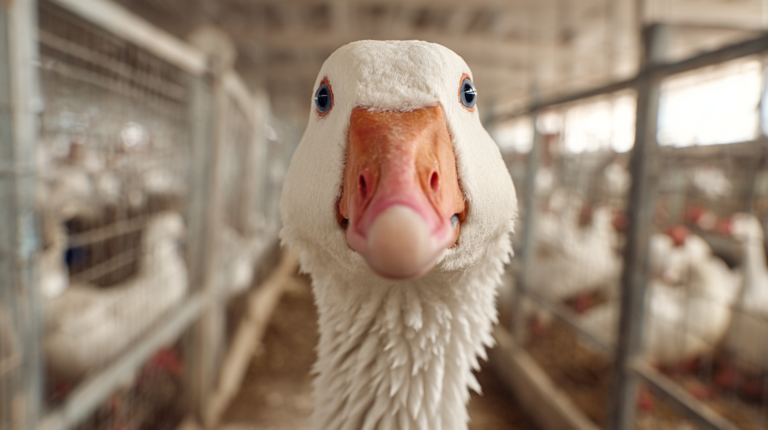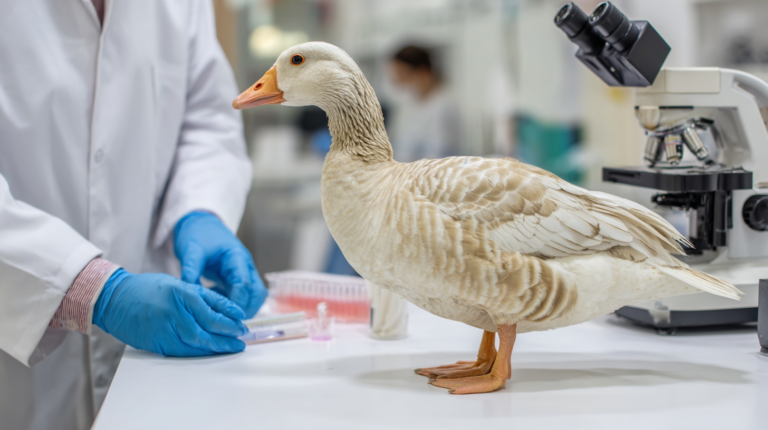Discover essential facts about intestinal parasites in geese, including symptoms, treatment, and prevention strategies. Expert veterinary advice for healthy waterfowl care.
Table of Contents
Keeping geese healthy requires understanding the threats they face, and among the most common yet overlooked challenges are intestinal parasites in geese. These microscopic invaders can wreak havoc on your flock’s digestive system, leading to poor growth, decreased egg production, and in severe cases, death. Whether you’re a seasoned waterfowl keeper or just starting your journey with these magnificent birds, recognizing and managing parasitic infections is crucial for maintaining a thriving flock.
Intestinal parasites affect an estimated 60-80% of domestic geese at some point in their lives, making this knowledge essential for any responsible goose owner. From the subtle early warning signs to comprehensive treatment protocols, understanding these parasites can mean the difference between a healthy, productive flock and one struggling with chronic health issues.
Understanding the Threat:
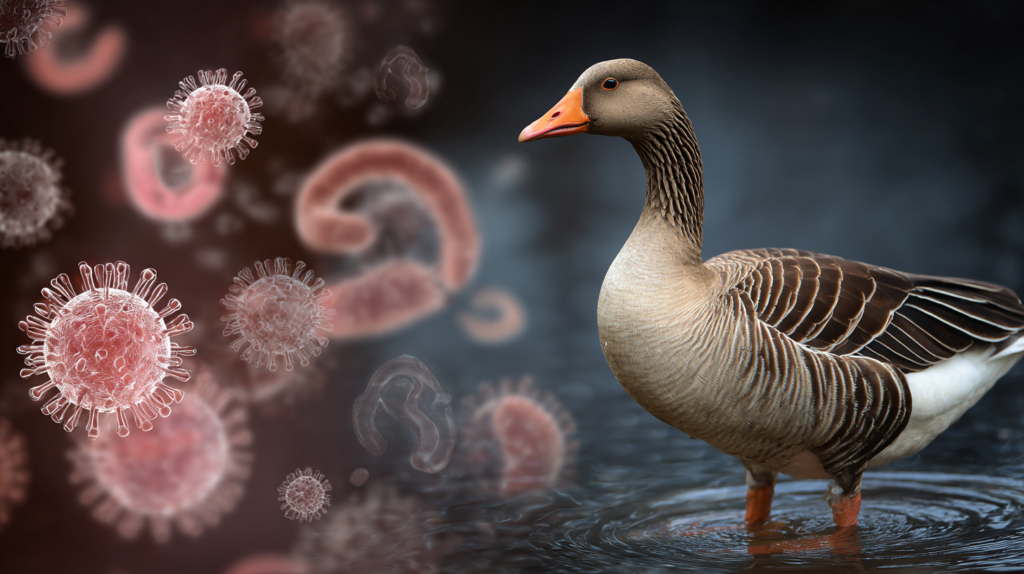
What Are Intestinal Parasites in Geese?
Intestinal parasites are organisms that live within the digestive tract of geese, deriving nutrients from their host while often causing significant harm. These parasites range from microscopic protozoa to visible worms that can measure several inches in length. The most common types affecting geese include roundworms (Ascaridia), tapeworms (Hymenolepis), and various protozoan parasites such as coccidia.
The lifecycle of these parasites varies significantly, but most follow a pattern of egg production, environmental contamination, and reinfection. Understanding these cycles is crucial because it helps determine the most effective intervention points. For instance, roundworm eggs can survive in soil for months, creating ongoing reinfection risks even after treatment.
Research from the American Veterinary Medical Association indicates that parasitic infections are responsible for approximately 15-20% of all waterfowl health issues reported to veterinary clinics. This statistic underscores the importance of proactive parasite management in goose husbandry.
Geese are particularly susceptible to parasitic infections due to their feeding habits and environmental preferences. They graze close to the ground, often in moist areas where parasite eggs and larvae thrive. Their natural tendency to eat a varied diet, including insects and organic matter, increases their exposure to intermediate hosts that carry parasites.
| Parasite Type | Common Species | Symptoms | Risk Level | Treatment Approach |
|---|---|---|---|---|
| Roundworms | Ascaridia galli, Heterakis gallinarum | Weight loss, poor growth, diarrhea | High | Anthelmintics, environmental management |
| Tapeworms | Hymenolepis species | Weight loss, poor feather quality | Medium | Praziquantel, intermediate host control |
| Coccidia | Eimeria species | Bloody diarrhea, dehydration | Very High | Anticoccidials, supportive care |
| Giardia | Giardia duodenalis | Chronic diarrhea, malabsorption | Medium | Metronidazole, water quality improvement |
| Capillaria | Capillaria species | Crop inflammation, regurgitation | High | Levamisole, habitat modification |
| Cryptosporidium | Cryptosporidium baileyi | Respiratory and intestinal symptoms | High | Supportive care, hygiene improvement |
Early Warning Signs Are Often Subtle
Recognizing intestinal parasites in geese requires keen observation skills, as early symptoms can be easily mistaken for other conditions or dismissed as normal variations in behavior. The most telling early indicators include changes in droppings consistency, subtle shifts in appetite, and minor alterations in normal behavior patterns.
Healthy goose droppings should be well-formed with a distinctive white uric acid cap. When intestinal parasites are present, you might notice increased frequency of defecation, looser consistency, or changes in color. However, these changes often occur gradually, making them easy to overlook during routine flock checks.
Weight loss is another early indicator, though it may not be immediately apparent in adult geese with good body condition. Young goslings are particularly vulnerable, and parasitic infections can significantly impact their growth rates. A gosling that appears to be eating normally but isn’t gaining weight at the expected rate may be harboring intestinal parasites.
Behavioral changes often precede physical symptoms. Infected geese may become less active, spend more time near water sources, or show decreased interest in foraging. These subtle changes in demeanor can be the first clue that something is amiss with your flock’s health.
Dr. Sarah Mitchell, a veterinary parasitologist at the University of Minnesota, notes: “The challenge with diagnosing parasitic infections in geese is that the birds are remarkably stoic. By the time obvious symptoms appear, the infection has often progressed significantly. Regular fecal examinations are far more reliable than waiting for clinical signs.”
Feather quality can also serve as an early warning system. Parasites compete with the host for nutrients, and this competition often manifests first in the condition of the feathers. Look for dull, brittle feathers or delayed molting patterns, especially in younger birds.
Common Parasite Types Require Different Treatment Approaches
Not all intestinal parasites in geese are created equal, and effective treatment depends on accurate identification of the specific parasite type. The three main categories—roundworms, tapeworms, and protozoans—each require distinct therapeutic approaches and have different implications for flock management.
Roundworms, particularly Ascaridia species, are among the most common parasites affecting geese. These large, visible worms can reach lengths of 3-4 inches and are often seen in heavy infections. Adult roundworms live in the small intestine, where they compete directly with the host for nutrients. Treatment typically involves the use of anthelmintics such as fenbendazole or ivermectin, administered according to specific dosing protocols.
Tapeworms present a different challenge entirely. These segmented parasites require intermediate hosts, typically small crustaceans or insects, to complete their lifecycle. This means that treatment must address not only the adult worms in the goose but also the environmental factors that allow reinfection. Praziquantel is the treatment of choice for tapeworm infections, but prevention requires managing access to intermediate hosts.
Protozoal parasites, including various coccidia species, are microscopic but can cause severe disease, particularly in young birds. These single-celled organisms multiply rapidly within the intestinal tract, causing inflammation and damage to the intestinal lining. Treatment often involves anticoccidial drugs such as amprolium or sulfadimethoxine, combined with supportive care to address dehydration and nutritional deficiencies.
The timing of treatment is crucial for all parasite types. Many anthelmintics work by interfering with the parasite’s ability to absorb nutrients or by paralyzing the worms, but they may not be effective against all life stages. This is why many treatment protocols involve multiple doses spaced several weeks apart to catch parasites as they mature.
Resistance to antiparasitic drugs is an emerging concern in waterfowl management. Overuse or inappropriate use of these medications can lead to the development of resistant parasite populations. This makes accurate diagnosis and targeted treatment even more important than in the past.
Environmental Management Is as Important as Treatment
While medication can eliminate existing parasites, long-term success in managing intestinal parasites in geese depends heavily on environmental management strategies. The environment where geese live, feed, and drink provides the reservoir for parasite eggs and larvae, making habitat modification a crucial component of any comprehensive parasite control program.
Moisture management represents one of the most critical environmental factors. Most parasite eggs and larvae require moist conditions to survive and develop. Areas where water pools, particularly around waterers and in low-lying sections of pastures, become hotspots for parasite development. Installing proper drainage and relocating water sources periodically can significantly reduce parasite loads in the environment.
Grazing rotation is another powerful tool for breaking parasite cycles. Many intestinal parasites require specific environmental conditions and time periods to develop from eggs to infective larvae. By rotating geese through different paddocks and allowing areas to “rest” for 4-6 weeks, you can significantly reduce the number of infective parasites in the environment.
The concept of “clean ground” is particularly relevant for goslings and young geese. These birds are more susceptible to parasitic infections and can suffer more severe consequences. Providing recently mowed or cultivated areas for young birds, away from areas where adult geese have been grazing, can dramatically reduce their exposure to parasites.
Stocking density plays a crucial role in parasite transmission. Overcrowded conditions lead to increased contamination of the environment with parasite eggs and create stress that can compromise the birds’ immune systems. Research indicates that reducing stocking density by just 25% can result in a 40-50% reduction in parasite loads over time.
Water quality management extends beyond just providing clean drinking water. Stagnant water bodies can harbor intermediate hosts for certain parasites and provide breeding grounds for vectors. Regularly cleaning and refreshing water sources, and ensuring adequate water flow in ponds or streams, helps create conditions less favorable to parasite development.
Composting manure properly is essential for breaking parasite cycles. Fresh manure should never be applied directly to areas where geese graze, as this can dramatically increase parasite contamination. Proper composting, with temperatures reaching 140°F (60°C) for several days, effectively destroys parasite eggs and larvae.
Nutritional Support Enhances Natural Resistance
The relationship between nutrition and parasite resistance in geese is complex and multifaceted. While proper nutrition cannot prevent parasitic infections entirely, it plays a crucial role in determining the severity of infections and the bird’s ability to recover from treatment. Understanding how to optimize nutritional support can significantly improve outcomes in managing intestinal parasites in geese.
Protein requirements increase during parasitic infections as the bird’s body works to repair damaged intestinal tissues and mount an immune response. Geese with access to high-quality protein sources, including both plant and animal proteins, show better resistance to parasitic infections and recover more quickly from treatment. Increasing dietary protein by 2-3% above normal requirements during treatment periods can support faster recovery.
Vitamin A deficiency has been directly linked to increased susceptibility to parasitic infections. This vitamin is essential for maintaining the integrity of mucous membranes, including those lining the digestive tract. Geese with adequate vitamin A levels show stronger barrier function in their intestinal walls, making it more difficult for parasites to establish infections.
Trace minerals, particularly zinc and selenium, play crucial roles in immune function and wound healing. Zinc deficiency can severely compromise the immune system’s ability to respond to parasitic infections, while selenium works as an antioxidant, helping to protect cells from damage caused by the immune response to parasites.
Probiotics and prebiotics have shown promise in supporting gut health and potentially reducing parasite loads. These beneficial bacteria compete with parasites for nutrients and attachment sites in the intestinal tract. Some research suggests that geese with healthy gut microbiomes may be more resistant to certain types of parasitic infections.
The timing of nutritional support is particularly important during treatment periods. Many antiparasitic medications can cause temporary digestive upset, and providing easily digestible, nutrient-dense foods during this time can help minimize treatment-related stress and support faster recovery.
Water intake often decreases during parasitic infections, which can lead to dehydration and concentrate toxins in the body. Ensuring constant access to clean, fresh water and monitoring water consumption can help identify problems early and support the bird’s natural detoxification processes.
| Prevention Strategy | Implementation Method | Frequency | Priority | Expected Outcome |
|---|---|---|---|---|
| Pasture Rotation | Move geese to fresh grazing areas regularly | Every 2-3 weeks | High | Breaks parasite life cycles, reduces environmental contamination |
| Water Source Management | Provide clean, fresh water; prevent stagnant pools | Daily | High | Reduces waterborne parasite transmission |
| Fecal Testing | Regular microscopic examination of droppings | Monthly (grazing season) | High | Early detection and treatment intervention |
| Quarantine Protocol | Isolate new birds for 30 days with testing | As needed | High | Prevents introduction of new parasites to flock |
| Nutritional Support | Balanced diet with immune-supporting supplements | Ongoing | Medium | Enhances natural resistance to parasitic infections |
| Drainage Improvement | Eliminate wet, muddy areas in housing and pasture | Seasonal maintenance | Medium | Reduces parasite survival in environment |
| Density Management | Maintain appropriate stocking rates | Ongoing monitoring | Medium | Prevents stress and overcrowding-related infections |
| Equipment Sanitation | Regular cleaning and disinfection of feeders, waterers | Weekly | Low | Eliminates parasite eggs from feeding equipment |
Prevention Strategies Outweigh Treatment Approaches
The most effective approach to managing intestinal parasites in geese focuses on prevention rather than treatment. While treatment options exist for most parasitic infections, prevention strategies offer better long-term outcomes with fewer health risks and lower costs. Developing a comprehensive prevention program requires understanding parasite lifecycles, environmental factors, and management practices that reduce infection risk.
Quarantine protocols for new birds represent the first line of defense against introducing parasites to an existing flock. New geese should be isolated for a minimum of 30 days, during which time they should receive fecal examinations and, if necessary, treatment before joining the main flock. This quarantine period allows time for any parasites to become detectable and prevents the introduction of new parasite strains to the established flock.
Regular fecal monitoring forms the cornerstone of any prevention program. Monthly fecal examinations during the grazing season can detect parasitic infections before they become severe enough to cause clinical signs. This early detection allows for targeted treatment that is more effective and less stressful for the birds.
Biosecurity measures extend beyond quarantine to include visitor protocols, equipment sanitization, and wildlife management. Wild waterfowl can introduce parasites to domestic flocks, making it important to minimize contact between wild and domestic birds. This might involve using netting over small ponds or adjusting feeding schedules to avoid times when wild birds are most active.
Breeding management can influence parasite resistance in future generations. Selecting breeding stock from birds that show good resistance to parasitic infections can gradually improve the overall health of the flock. This doesn’t mean avoiding treatment when necessary, but rather noting which birds seem to handle parasitic challenges better and favoring them in breeding decisions.
Seasonal management strategies recognize that parasite risks vary throughout the year. Spring and fall migrations often bring increased contact with wild birds, while summer heat and humidity create ideal conditions for parasite development. Adjusting management practices seasonally, such as increasing monitoring frequency during high-risk periods, can help prevent serious outbreaks.
Diagnostic Methods and Testing Protocols
Accurate diagnosis is essential for effective management of intestinal parasites in geese. While clinical signs can provide clues about the presence of parasites, definitive diagnosis requires laboratory testing. Understanding available diagnostic methods and their limitations helps ensure appropriate treatment decisions.
Fecal flotation remains the gold standard for diagnosing most intestinal parasites in geese. This technique uses specialized solutions with specific gravity higher than parasite eggs, causing the eggs to float to the surface where they can be identified under microscopic examination. Different flotation solutions are optimal for different parasite types, and skilled technicians can identify parasites to the species level.
Direct fecal smears can provide rapid results but are less sensitive than flotation methods. This technique involves mixing fresh feces with a small amount of water or saline and examining the mixture immediately under a microscope. While direct smears can miss light infections, they are useful for detecting motile parasites and can provide immediate information in clinical situations.
Quantitative methods, such as the McMaster technique, can determine the number of parasite eggs per gram of feces. This information is valuable for assessing the severity of infections and monitoring treatment effectiveness. High egg counts often correlate with more severe clinical disease and may indicate the need for more aggressive treatment.
The timing of sample collection affects diagnostic accuracy. Parasite egg shedding can be intermittent, particularly in light infections or during certain stages of the parasite lifecycle. Collecting samples from multiple birds over several days increases the likelihood of detecting parasites when they are present.
Fresh samples provide the most accurate results, but proper storage can extend the diagnostic window. Refrigerated samples remain viable for several days, while frozen samples can be stored longer but may affect the survival of certain parasite stages. Understanding proper sample handling ensures reliable diagnostic results.
Treatment Protocols and Medication Guidelines
Successful treatment of intestinal parasites in geese requires understanding both the specific medications available and the proper protocols for their use. Each class of antiparasitic drugs works through different mechanisms, and proper dosing and timing are crucial for effectiveness while minimizing the risk of resistance development.
Fenbendazole represents one of the most commonly used anthelmintics for treating roundworm infections in geese. This benzimidazole compound works by disrupting the parasite’s ability to absorb glucose, effectively starving the worms. The standard dose for geese is 20-50 mg/kg body weight, administered orally for 3-5 consecutive days. The medication can be mixed with feed or administered directly by oral gavage.
Ivermectin, an avermectin compound, is effective against both internal and external parasites. For geese, the typical dose is 0.2-0.4 mg/kg body weight, administered either orally or by subcutaneous injection. Ivermectin is particularly effective against roundworms and some external parasites, but it has limited effectiveness against tapeworms and protozoal parasites.
Praziquantel serves as the treatment of choice for tapeworm infections in geese. This medication works by affecting the parasite’s calcium metabolism, causing paralysis and death. The recommended dose is 10-20 mg/kg body weight, administered orally as a single dose. In severe infections, the treatment may be repeated after 2-3 weeks.
Anticoccidial drugs, such as amprolium or sulfadimethoxine, are used to treat protozoal infections. These medications work by interfering with the parasite’s metabolic processes. Treatment protocols typically involve 5-7 days of medication, with dosing based on the concentration of active ingredient in the drinking water.
Combination treatments may be necessary for mixed infections, which are common in geese. However, combining medications requires careful consideration of potential interactions and increased risk of toxicity. Consultation with a veterinarian experienced in waterfowl medicine is essential when considering combination therapies.
| Timeline | Diagnostic Actions | Treatment Protocol | Monitoring Requirements | Expected Results |
|---|---|---|---|---|
| Day 0 Initial Assessment |
• Fecal sample collection • Clinical examination • Weight recording • Symptom documentation |
• Begin supportive care • Isolate affected birds • Ensure adequate hydration • Await diagnostic results |
• Observe eating/drinking • Monitor droppings consistency • Record activity levels • Document symptoms |
Baseline established Parasite identification pending |
| Day 1-2 Diagnosis & Treatment Start |
• Microscopic examination • Parasite identification • Egg count assessment • Species confirmation |
• Begin targeted medication • Administer first dose • Adjust diet if needed • Continue supportive care |
• Monitor for adverse reactions • Track medication compliance • Continue symptom monitoring • Record treatment responses |
Treatment initiated Early response indicators visible |
| Day 3-5 Early Treatment Phase |
• Daily clinical assessment • Weight monitoring • Appetite evaluation • Dropping consistency check |
• Continue medication course • Maintain dosing schedule • Provide nutritional support • Environmental modifications |
• Daily weight checks • Monitor improvement signs • Track medication side effects • Record behavioral changes |
Initial improvement expected Appetite may return Dropping consistency improves |
| Day 7-10 Mid-Treatment Assessment |
• Treatment effectiveness check • Clinical improvement assessment • Weight gain evaluation • Symptom resolution tracking |
• Complete medication course • Continue supportive care • Gradual diet normalization • Maintain isolation if needed |
• Weekly weight monitoring • Activity level assessment • Feather quality observation • Social behavior evaluation |
Significant improvement visible Normal behavior returning Weight stabilization |
| Day 10-14 Treatment Completion |
• Post-treatment fecal exam • Parasite clearance confirmation • Egg count reassessment • Treatment efficacy evaluation |
• Medication course completed • Observe withdrawal periods • Gradual reintroduction to flock • Continue nutritional support |
• Confirm parasite elimination • Monitor for reinfection signs • Assess flock reintegration • Continue behavior monitoring |
Treatment success confirmed Normal parasite levels Flock reintegration ready |
| Day 30+ Long-term Monitoring |
• Monthly fecal screenings • Seasonal health assessments • Preventive testing protocols • Environmental monitoring |
• Implement prevention strategies • Pasture rotation maintenance • Nutritional optimization • Environmental management |
• Ongoing health surveillance • Seasonal risk assessment • Flock performance tracking • Prevention protocol compliance |
Sustained parasite control Healthy flock maintenance Prevention success |
Monitoring Recovery and Long-term Management
Effective management of intestinal parasites in geese extends beyond initial treatment to include monitoring recovery and implementing long-term prevention strategies. Understanding how to assess treatment effectiveness and maintain flock health requires ongoing attention to both clinical signs and diagnostic testing.
Post-treatment monitoring should begin within 7-14 days after completing medication. Follow-up fecal examinations can confirm treatment effectiveness and detect any parasites that may have survived the initial treatment. The timing of post-treatment testing is crucial, as it may take several days for dead parasites to be eliminated from the digestive system.
Weight monitoring provides an objective measure of recovery progress. Geese recovering from parasitic infections should show steady weight gain, particularly if weight loss was a presenting sign. Daily or weekly weight checks during the recovery period can help identify birds that may need additional treatment or supportive care.
Behavioral observations during recovery should focus on activity levels, appetite, and social interactions. Recovered geese typically show increased energy levels, improved appetite, and more normal social behaviors. Birds that remain lethargic or show decreased appetite may require additional evaluation.
Long-term management strategies should address the underlying factors that contributed to the initial infection. This might involve modifying grazing patterns, improving drainage in problem areas, or adjusting stocking densities. The goal is to create conditions that minimize reinfection risk while maintaining good bird welfare.
Record keeping plays a crucial role in long-term parasite management. Maintaining detailed records of treatments, test results, and environmental conditions helps identify patterns and risk factors. This information is valuable for developing targeted prevention strategies and can help veterinarians make more informed treatment decisions.
Seasonal Considerations and Risk Assessment
Understanding the seasonal patterns of intestinal parasites in geese is essential for developing effective prevention and management strategies. Parasite risks vary significantly throughout the year, influenced by temperature, humidity, wildlife activity, and changes in goose behavior and physiology.
Spring presents unique challenges as warming temperatures create favorable conditions for parasite development while migration patterns bring increased contact with wild waterfowl. This combination often results in increased parasite transmission during the spring months. Implementing intensified monitoring programs during this period can help detect infections early when they are most treatable.
Summer heat and humidity create ideal conditions for parasite egg development and survival in the environment. Many parasite species show accelerated development times during warm weather, leading to more rapid buildup of infective larvae in grazing areas. Increased attention to environmental management becomes particularly important during summer months.
Fall migration patterns can introduce new parasite strains to established flocks as wild birds move through the area. This period often coincides with breeding season for many parasites, potentially leading to increased environmental contamination. Implementing biosecurity measures to minimize contact between wild and domestic birds becomes crucial during fall months.
Winter conditions generally reduce parasite activity and development rates, but indoor housing can create new challenges. Increased stocking density and reduced access to natural foraging can stress birds and make them more susceptible to parasitic infections. Maintaining good ventilation and sanitation becomes particularly important during winter housing periods.
Breeding season considerations are particularly important for goose flocks. Nutritional demands increase during egg production, and parasitic infections can significantly impact reproductive performance. Timing parasite control measures to avoid the peak breeding period while ensuring birds are parasite-free during this crucial time requires careful planning.
Frequently Asked Questions
Expert answers about intestinal parasites in geese
Monthly fecal examinations during the grazing season (April through October) are recommended for most flocks. During winter months, testing every 2-3 months is usually sufficient unless clinical signs suggest a problem. New birds should always be tested before joining the flock, and any bird showing symptoms of illness should be tested immediately.
While most intestinal parasites that affect geese are species-specific and don’t infect humans, some parasites can cause zoonotic infections. Proper hygiene when handling birds and their environment is essential. Always wash hands thoroughly after contact with geese or their living areas, and avoid eating or drinking in areas where birds are kept.
Withdrawal periods for eggs vary depending on the medication used. Most antiparasitic drugs require a 1-7 day withdrawal period before eggs can be consumed. Always follow the specific withdrawal recommendations for any medication used, and consult with a veterinarian if you’re unsure about withdrawal times.
While some natural products may have antiparasitic properties, they are generally not reliable as primary treatments for established parasitic infections. Natural approaches work best as part of a comprehensive prevention program rather than as treatment for active infections. Always consult with a veterinarian before relying on natural remedies for treating parasites.
Reinfection typically occurs due to environmental contamination with parasite eggs or larvae. Treatment kills adult parasites but doesn’t eliminate eggs from the environment. Implementing proper environmental management, including pasture rotation and improved drainage, is essential for preventing reinfection cycles.
Treatment effectiveness should be assessed through follow-up fecal examinations 10-14 days after completing medication. Clinical improvement, including better appetite, increased activity, and normalized droppings, may be seen within a few days of treatment. Weight gain and improved feather quality are longer-term indicators of successful treatment.
No questions match your search. Try different keywords or browse all questions above.
Supporting Your Flock’s Health Through Professional Care
Managing intestinal parasites in geese requires a comprehensive approach that combines accurate diagnosis, appropriate treatment, and preventive management strategies. While this information provides a foundation for understanding parasitic diseases in geese, working with a veterinarian experienced in waterfowl medicine is essential for developing an effective parasite management program tailored to your specific situation.
Regular veterinary check-ups can help identify potential problems before they become serious health issues. Many veterinarians offer flock health programs that include routine parasite monitoring, vaccination protocols, and nutritional counseling. These programs can be particularly valuable for larger flocks or commercial operations where parasite management is critical to economic success.
For more expert pet care tips and product recommendations, visit https://BlithePet.com — your trusted source for pet wellness.
Conclusion
Understanding and managing intestinal parasites in geese requires vigilance, knowledge, and a comprehensive approach to flock health. The five critical facts outlined in this article—recognizing subtle early signs, understanding different parasite types, implementing environmental management, providing nutritional support, and prioritizing prevention—form the foundation of effective parasite control.
Success in managing parasitic infections depends on consistent monitoring, appropriate treatment when necessary, and most importantly, creating conditions that minimize infection risk. By implementing these strategies and working closely with veterinary professionals, you can maintain a healthy, productive flock that thrives despite the constant challenge of parasitic diseases.
Remember that parasite management is an ongoing process, not a one-time event. Seasonal variations, environmental changes, and flock dynamics all influence parasite risk, requiring adaptive management strategies. Stay informed about new developments in parasite control, maintain accurate records, and don’t hesitate to seek professional guidance when facing complex situations.
The investment in proper parasite management pays dividends in improved bird health, better production performance, and reduced long-term treatment costs. Your geese depend on you to provide the knowledge and care necessary to protect them from these persistent threats.
Have a similar experience with your pet? Share it in the comments below!

